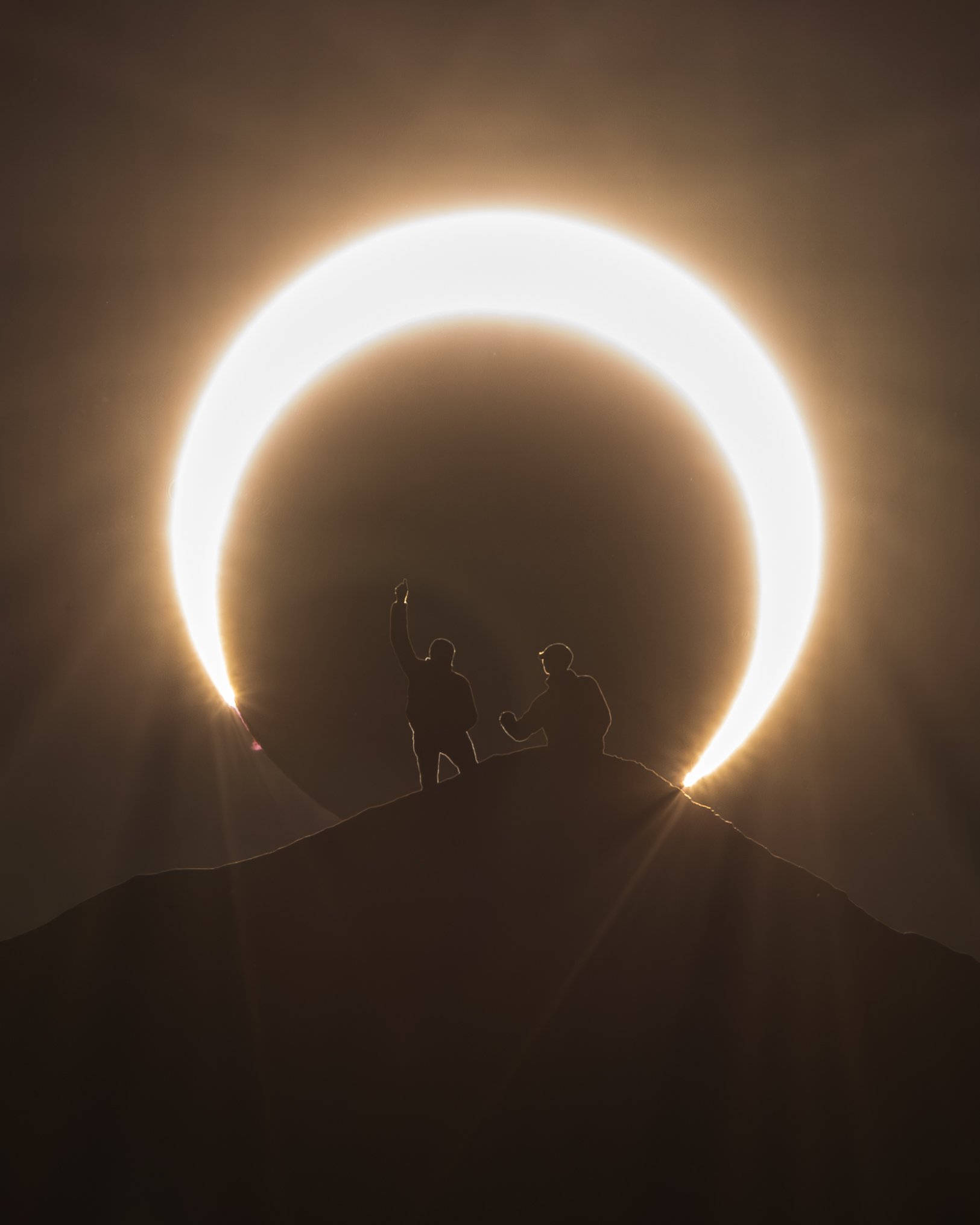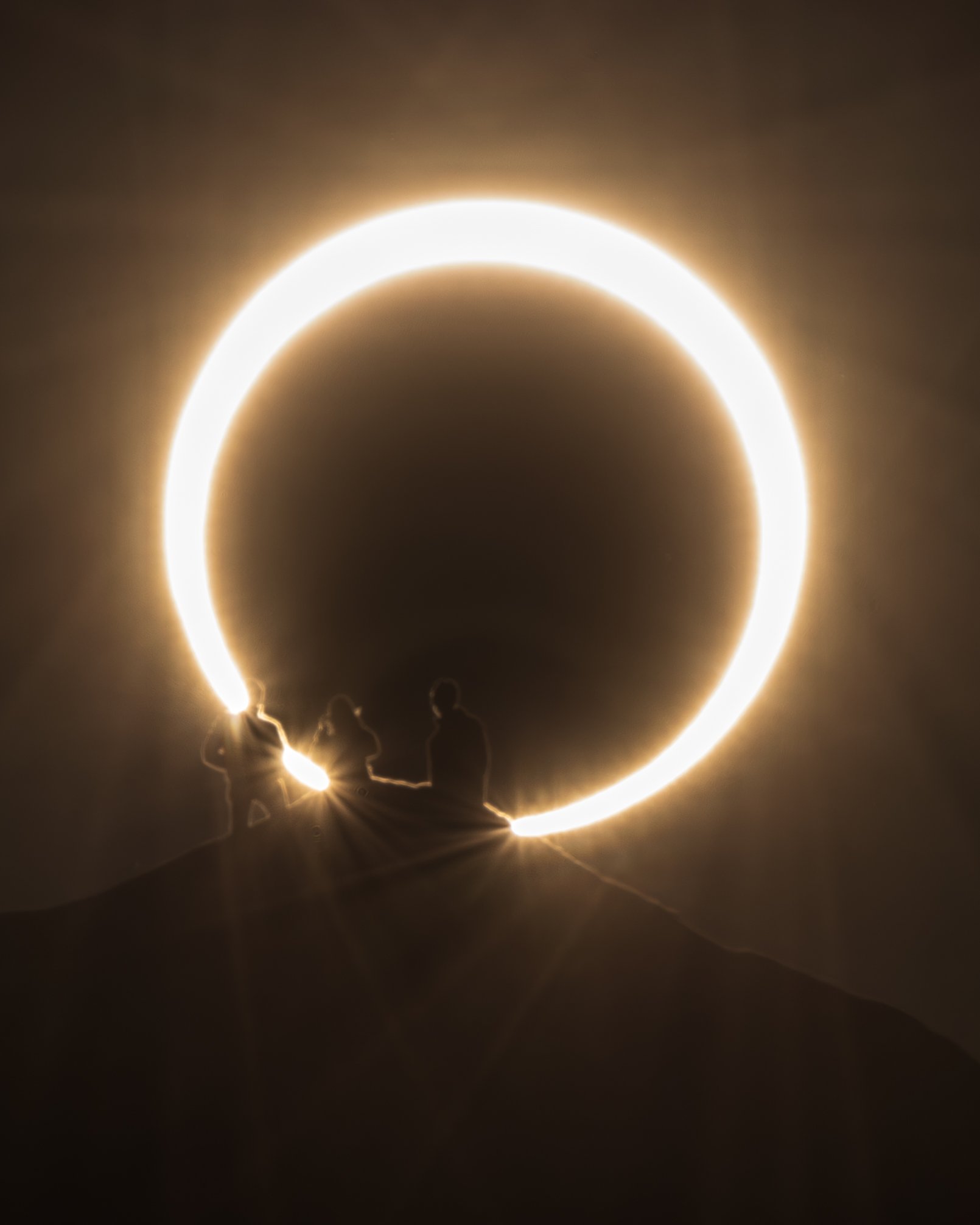Behind the Shots: Ring of Fire Eclipse
Photo of annular eclipse viewers on October 14th, 2023.
Single Exposure 🔹 600mm 🔹 F/18 🔹 1/3200 sec. 🔹 ISO 50
I started planning for photos of the annular eclipse of October 14th 8 months in advance, and made a scouting trip to a location where I envisioned I would end up shooting the eclipse. After analyzing some things in planning apps and multiple scouting trips, that first plan fell through. After the 2nd and 3rd plans fell through as well, both at completely different locations, I considered it might be a sign from the universe that maybe I was just supposed to observe this one, and leave the camera behind. I had one final idea though, which was to show up at a place that I thought would work and would also be a popular spot for campers, so I could find some random strangers willing to pose for me.
Photo of October 14th, 2023 annular eclipse.
Single Exposure 🔹 600mm 🔹 F/18 🔹 1/5000 sec. 🔹 ISO 50
After flying around some in Google Earth and checking some angles, I confirmed that Muley Point near Mexican Hat, Utah should work well. In fact, I mapped out 4 potential spots for subjects to stand up on a cliff, and my coinciding spots down below. It was more than a 2-hour drive away and I was confident I should be fine without needing to scout it out in advance, saving me an extra trip before the eclipse. When I arrived there a couple days before though, I was surprised to find that none of the 4 options would work. The area is filled with large boulders, and they obstructed the line of site for all 4 spots. It would definitely take some extra planning on the fly if I was to pull anything off with a human subject. Fortunately, I had a couple days to figure things out. To complicate things, even though I’d only be about a quarter mile from the from someone standing on the cliff, there was no easy way to hike between the top of the cliff and the bottom, which was a difference in elevation of about 1,000 feet. It required an hour drive, and most of that being dirt roads. In going back and forth for the planning and execution, I ended up driving about 60 miles on them.
Since I hadn’t visited the place before my trip for the eclipse, I figured it would be a good idea to have multiple options, so using planning apps and Google Earth, I mapped out 4 potential position sets for my and subjects (eclipse viewers) up on the cliff. Unfortunately, upon arriving to the scene, I found none of them would work. I spent the next day building a plan that would.
On Thursday, I found a position I thought would work for a person to stand on the cliff, but had to wait until Friday morning, the day before the eclipse, to confirm alignment with the sun on eclipse day would work. After that, I imagined walking around to various campsites in search of a stranger all day that would be willing to pose for me, but was lucky that the very first group I asked was willing to participate. Happy to join in my plans were Maxwell from Montana, and Keene and Sandee from Colorado, whose friendship brings them together nearly every year for a trip to the area. I showed them where they’d need to stand at the edge of the cliff, and left them with a 2-way radio and basic instructions for the shoot the next day.
Photo of October 14th, 2023 annular eclipse.
Single Exposure 🔹 600mm 🔹 F/18 🔹 1/5000 sec. 🔹 ISO 50
We were in our respective positions on the morning of the eclipse, and moments before the maximum phase, or the “Ring of Fire”, I realized my calculated location was off by quite a bit. I had been afraid that if that happened, it would be difficult to find a new place that would work, as the entire area consisted of steep and rocky terrain. For that reason, I had spent a good amount of time there beforehand, observing the surrounding boulders and potential spots to move if my calculations were off. This paid off. While I still had to scramble and hurry, I was able to reposition myself for the shots.
After getting some photos with the crew on the cliff, I put on a filter and took some shots of the eclipse alone. The reddish reflection is an optical lens flare.
Single Exposure 🔹 600mm 🔹 F/18 🔹 1/5000 sec. 🔹 ISO 50
Aside from the logistics of the shoot being the most challenging I’ve ever experienced, the technical side of things were also the most difficult I’ve dealt with. Photographing the eclipse alone is far from easy, and throwing in some human subjects certainly complicates things. It is recommended to photograph an eclipse with a filter to avoid frying your camera sensor, since the lens can act as a magnifying glass like you used to use to burn ants and leaves as a child. The problem though, is my filter was very strong and blocked so much light that it would be difficult to see anything else aside from the sun. Without a filter you have the opposite problem, and it would be impossible to get an image that wasn’t overexposed. Even with testing in advance, the specific conditions of the eclipse can’t be replicated very well. Since the maximum eclipse was nearly 5 minutes long, I decided to try some shots with a solar filter, and some without. My gut told me that the shots without the filter would be the better ones, and I was ok with the risk of my camera getting destroyed. While actually shooting the eclipse, I recognized fairly quickly that the filterless shots would indeed be better, so I shot mostly without it. Sometimes it can be hard to tell how photos will turn out, even as you can review them on the camera screen, but as I was photographing the crew upon the cliff, I had a pretty good feeling we’d have some cool-looking shots. Afterwards, I drove the hour around to the top of the cliff. Maxwell had already taken off, but I was able to talk to Keene and Sandee and show them the photos on my camera. I had their email addresses and sent them the photos afterwards so they’d have them as mementos from their eclipse experience.
Nearby where I photographed the eclipse was this beautiful panel of petroglyphs. Did you notice the duck heads?
Solar eclipse photography is extremely difficult, and because of their rarity, there’s only so much practice you can do beforehand. Despite the technical considerations to be aware of, as well as the potential logistical challenges, it’s such a rewarding experience to be able to see and capture such an awe-inspiring cosmic event. The next solar eclipse in the US, on April 8th, 2024, will be an even more impressive total eclipse, which I recommend to anyone and everyone to go see. You can find info on that one here if you’re interested.





